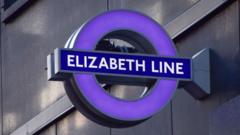Did the Elizabeth Line Drive Up Rental Prices?

Published: 2025-10-20 08:00:27 | Category: technology
The Elizabeth line has significantly altered the rental landscape in London and its surrounding areas since its opening in May 2022. Although it has improved connectivity and access, it has also contributed to rising rents, particularly in areas like Ealing and Slough. This article explores the impact of the Elizabeth line on rental prices, highlighting key statistics and trends that showcase the broader implications for young renters and the housing market.
Last updated: 04 October 2023 (BST)
Understanding the Elizabeth Line's Impact on Housing Costs
The Elizabeth line, now the UK's busiest railway, carries one in six train journeys across the country. This vital infrastructure project has brought forth both opportunities and challenges, especially for young people looking to rent or buy property in London. With significant rental increases observed along its route, the question arises: has the Elizabeth line made renting even more unaffordable for young people?
Key Takeaways
- The Elizabeth line opened in May 2022 and has become a crucial transport link.
- Rent prices in areas near Elizabeth line stations have risen by approximately 28% since June 2022.
- Specific areas like Ealing and Slough have seen rental increases as high as 53% and 30%, respectively.
- Flexible working arrangements post-pandemic have influenced rental demand in peripheral areas.
- While transport links have improved, the overall rental market remains challenging for many young people.
The Rise in Rental Prices Along the Elizabeth Line
According to the Office for National Statistics (ONS), average rents in areas adjacent to the Elizabeth line have increased by about 28% between June 2022 and June 2025. This rate aligns with the overall increase in London but surpasses the growth observed in the wider South East (22%) and the rest of the UK (24.5%). The rapid rise in rents can be attributed to enhanced connectivity, making these locations more appealing for renters.
Spotlight on Ealing: A Case Study
Ealing has emerged as a notable example, where rents have surged by approximately 30%. The borough is served by five Elizabeth line stations, making it a prime location for both locals and commuters. Tia Costell, a young renter in Ealing, shared her experience of navigating the challenging rental market. She managed to secure a home through the London Living Rent scheme, which provides affordable housing options for those on lower incomes.
Southall station, in particular, has seen the highest rental increase along the Elizabeth line, with two-bedroom properties rising from £1,288 in 2022 to £1,970 by 2025—a staggering 53% increase. This trend reflects a growing demand for rental properties in well-connected areas, further exacerbating the affordability crisis.
Regional Variations in Rental Growth
While Ealing has experienced steep rental increases, other areas along the Elizabeth line have also seen significant changes. Slough, located to the west of London, has witnessed rents climb by nearly a third, from £1,167 in June 2022 to £1,529 in June 2025. Kevin Sims, director of the shared ownership company SO Resi, noted that the Elizabeth line has opened Slough to a new demographic of renters, including families and professionals seeking easy access to London.
In contrast, Brentwood in Essex has exhibited the smallest rent increase along the line, with a modest rise of about 15%. Landlords in Brentwood acknowledge that the area has long benefited from its proximity to London, suggesting that the Elizabeth line has merely reinforced existing trends rather than instigating a new phenomenon.
The Role of Remote Working in Shaping Rental Demand
The Covid-19 pandemic has significantly reshaped working patterns, leading to a rise in flexible working arrangements. Many individuals now have the option to work from home, allowing them to consider living further from their workplace. This shift has made peripheral areas, particularly those serviced by the Elizabeth line, more attractive for potential renters. According to a report from Transport for London (TfL) and the Department for Transport, the improved connectivity from the Elizabeth line has heightened the appeal of these suburbs, resulting in increased demand and subsequent price growth.
Challenges in Assessing the Elizabeth Line's Impact
Scott Cabot, head of residential research at real estate consultancy CBRE, noted that the simultaneous arrival of the Elizabeth line and the shift in working patterns complicates the assessment of its true impact on the housing market. As the line enhances access to previously underserved areas, it is essential to consider how these changes interact with broader economic trends and lifestyle preferences.
Future Implications for Young Renters
The rising rents associated with the Elizabeth line underscore the ongoing challenges faced by young people in London. Many feel priced out of the market, struggling to find affordable housing options amidst soaring costs. Tia Costell's experience is emblematic of this struggle; while she appreciates the access the Elizabeth line provides, the reality of securing a home remains fraught with difficulties.
The Need for Affordable Housing Solutions
As the demand for rental properties continues to rise, it becomes increasingly crucial for policymakers to prioritise affordable housing initiatives. The London Living Rent scheme, which helped Tia find her home, represents one such solution, but more comprehensive measures will be necessary to address the broader housing crisis. The impact of the Elizabeth line presents both opportunities and challenges, and it will be essential to navigate these complexities moving forward.
Conclusion: Navigating the New Normal
The Elizabeth line has undeniably changed the rental landscape in London and its surrounding areas. While it has improved connectivity and access to previously underserved locations, it has also contributed to rising rents that challenge the affordability of housing for young people. As the market continues to evolve, stakeholders must work together to ensure that the benefits of improved transport links are shared equitably across communities.
As London adapts to these changes, the question remains: how can we ensure that the housing market remains accessible to all, particularly for young renters? The answers may lie in innovative policies and a commitment to affordable housing solutions. #LondonHousing #ElizabethLine #AffordableRent
FAQs
What is the Elizabeth line?
The Elizabeth line is a major railway line in London that opened in May 2022. It connects central London to areas in the west and east, significantly improving transport links.
How has the Elizabeth line affected rental prices?
Since its opening, rental prices in areas near Elizabeth line stations have risen by approximately 28%, with some areas experiencing increases as high as 53%.
Why are rents rising in Ealing?
Ealing has seen a significant rise in rents due to its proximity to five Elizabeth line stations, making it an attractive location for both commuters and residents.
What role did the pandemic play in rental trends?
The Covid-19 pandemic has led to more flexible working arrangements, allowing people to live further from their workplaces, thus increasing demand for properties in well-connected suburban areas.
What is the London Living Rent scheme?
The London Living Rent scheme is an initiative designed to provide affordable housing options for individuals and families on lower incomes, helping them secure rental properties in London.



